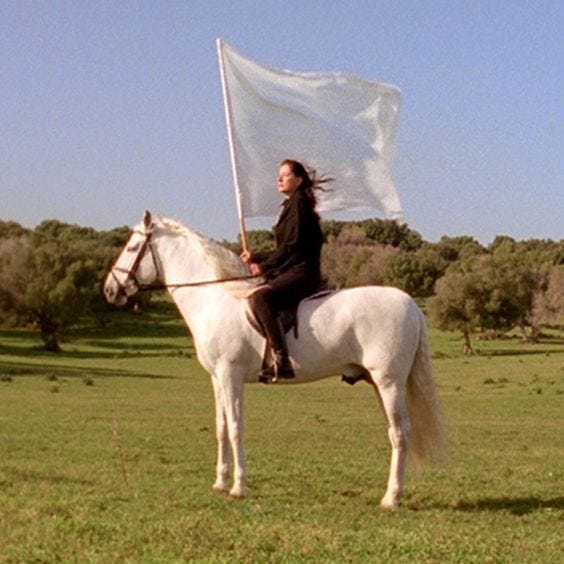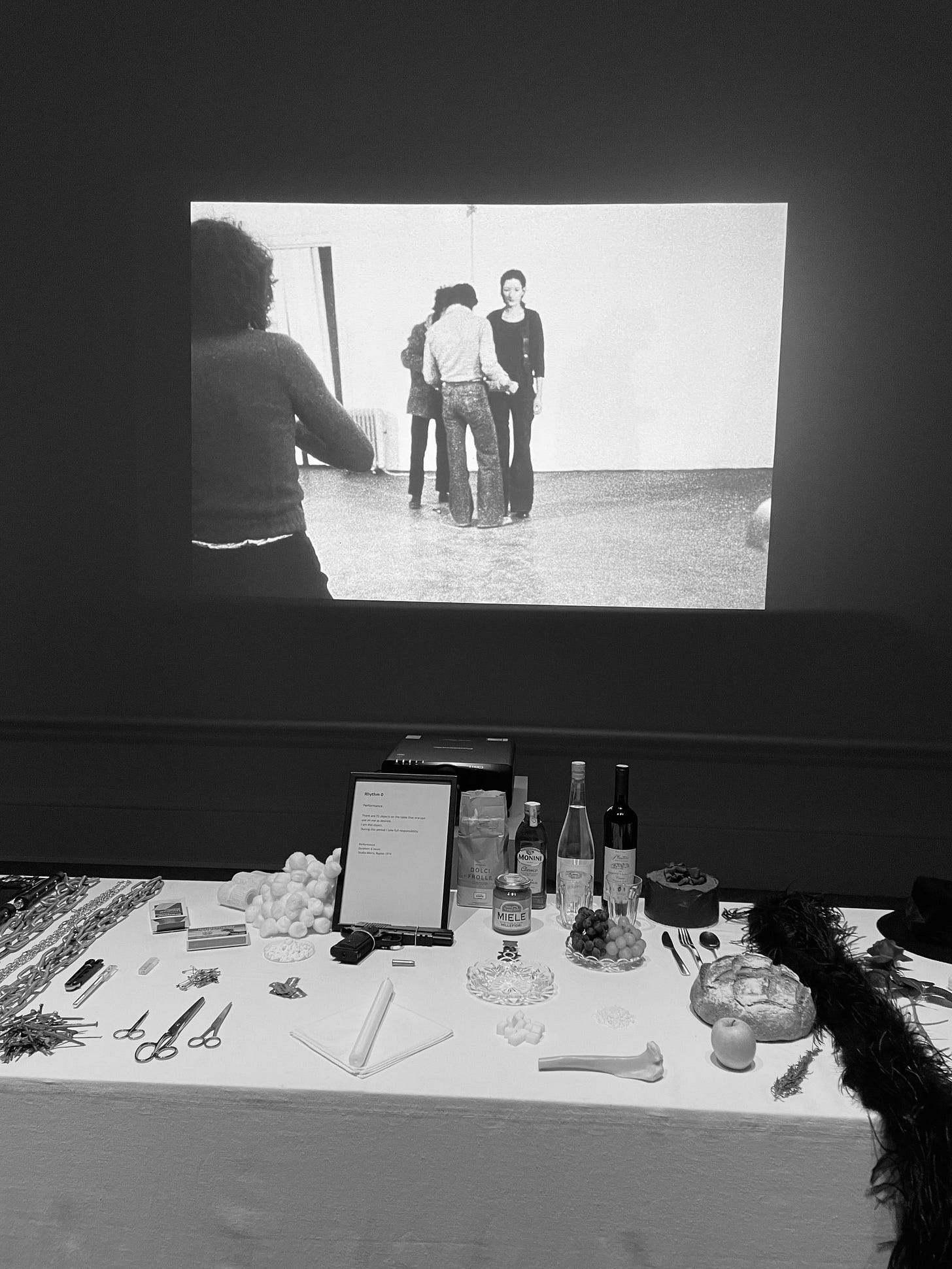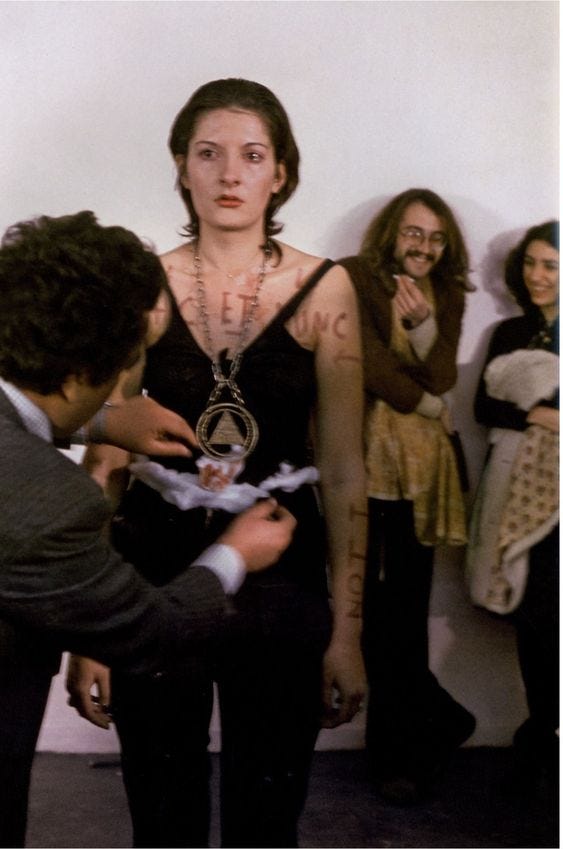The Influence of Marina Abramović
Art mother: One woman's analysis of human behaviour at the rawest, most cynical core
Marina Abramović’s presence is grippingly palpable, even if you look at her dark brown eyes and character-defining thick, black side braid through a photograph or screen. There’s something about her stare that makes you feel like you just walked into an X-ray, with every hidden emotion simultaneously held in a glass display. Most artists create a one-sided relationship with their viewers, providing them an opportunity to hear, see, or touch their creations. Abramović’s relationship goes both ways- she looks to her audience to not only understand their unique composition, but to theorize human behaviour holistically by performing the most intimate procedures. This duality is the foundation for some of her most infamous artistic pieces.
Abramović’s works of art intersect with the common processes of scientific studies. To achieve unpredicted outcomes inside of her control, she surrendured her power to the audience during multiple projects. She made herself the lab rat, the one to endure the tests. This cost the price of thousands of hours sitting in silence, her body cut and abused, and her most personal relationships broadcasted to the public. Her works have filtered into all spheres of her mental and physical being.
Why would one artist put her body and mind through traumatic, enormous amounts of strain? I’d like to believe it is for two reasons. Firstly, she is a martyr in her studies to understand human beings through methods never tried before. She is an explorer, a woman who has known sacrifice. Secondly, I believe Abramović has an insurmountable amount of love for humans. She is an artist who loves her audience, her work is created for us. She’s an art mother, the one who has endured in order to teach. Abramović is one-of-a-kind, a compassionate giver.
Here’s a look at some of her most famous works below:
The Artist is Present
In 2010, Abramović was present at the Museum of Modern Art every day for three months. This was her longest performance yet, lasting a total of 716 hours and thirty minutes. For every hour that the MoMA is open, she will sit without water, food, or breaks. Her ask, displayed on a small plaque, read “Sit silently with the artist for a duration of your choosing.”
Behind the plaque stood a queue of eager visitors. One by one, each sat in the chair across from hers and stared directly into her eyes. “I have the empty chair,” Abramović stated, “so everybody from the audience can come on his free time and sit in front of me, and engage in this kind of silence, experience of the here and now, the present moment. So you can observe this as a kind of stage for experience.”
“Or,” she continues, “you can really enter that space and take active participation, which actually brings you much closer to the artist, and this presence, and to your own experience. If you sit on this chair opposite of me, it's extremely important to actually find a very comfortable position and you don't move. Just sit motionless, and see what happens if we connect with our eyes. And I really think that it’s going to be something quite special to go into this unknown territory.”
Viewers of all demographics sat across from Abramović in the chair, some for minutes and some for hours. One participant, author Rebecca Taylor, describes her unique experience with Abramović and explains that it was nothing as expected. “For the first few minutes, I thought only about who this woman was—a renegade, a feminist, an inspiration—but quickly realized that those things were more about her persona than the person… We sat absolutely still in deafening silence, exchanging energy, and just being with each other. I’ve heard it said that couples married for decades can sit in silence and understand one another perfectly, but I’d never imagine that sort of intimacy could be possible between two total strangers. It is.”
Rhythm 0
Abramović’s Rhythm 0 comprised seventy-two objects set out on a long table with a white tablecloth, accompanied by sixty-nine slides projected onto the wall above it. The objects on the table range in attributes such as purpose, size, composition, weight, and colour. Some objects on the table included: gun, bullet, paint, comb, camera, rose, chains, feather, needle, knife, nails, lipstick, bandage, honey, salt, wine, scalpel, and water.
The performance lasted six hours. Abramović wrote written instructions that accompanied the work that said:
Instructions.
There are 72 objects on the table that one can use on me as desired.Performance
I am the object.
During this period I take full responsibility.
In the beginning, visitors were quite gentle. Some planted a kiss on her lips, while others gave her the rose from the table. However, as the night became darker, so did the audience’s intentions. The visitors were more violent, more forceful. Art critic Thomas McEvilley, who was present for the exhibit, stated, “In the third hour all her clothes were cut from her with razor-sharp blades. In the fourth hour, the same blades began to explore her skin. Her throat was slashed so someone could suck her blood. Various minor sexual assaults were carried out on her body. She was so committed to the piece that she would not have resisted rape or murder. Faced with her abdication of will, with its implied collapse of human psychology, a protective group began to define itself in the audience. When a loaded gun was thrust to Marina's head and her own finger was being worked around the trigger, a fight broke out between the audience factions."
Abramović endured hours of escalating torture in various humiliating, painful forms. She sacrificed her safety to the audience, without knowing what the audience’s limits could be. There were moments amid exhaustion, hunger, and fear when she believed that this art piece could be life-threatening. How did these ordinary visitors evolve to become barbaric and savage? Only in unique situations can humans demonstrate what they are capable of doing to one another.
"What I learned was that ... if you leave it up to the audience, they can kill you ... I felt really violated: they cut up my clothes, stuck rose thorns in my stomach, one person aimed the gun at my head, and another took it away. It created an aggressive atmosphere. After exactly 6 hours, as planned, I stood up and started walking toward the audience. Everyone ran away, to escape an actual confrontation."
This experiment teaches us more about the audience than it does about Abramović. Like many of her other works, her productions are more of a mirror to our own understandings rather than her own. Like mice in a science lab, we are placed in a specific, calculated environment and observed by the scientist to record the outcomes.
Are we as dignified and complex as we exclaim, or are we no better than vulgar, desperate animals who prey on one another? Thanks, Marina, for the food for thought.










Bri this is so incredible!! I never knew about Abramović and this has blown my mind in more ways than one. Your writing and analysis of her work is brilliant, perfectly captured the artist. Thank you! - Malini